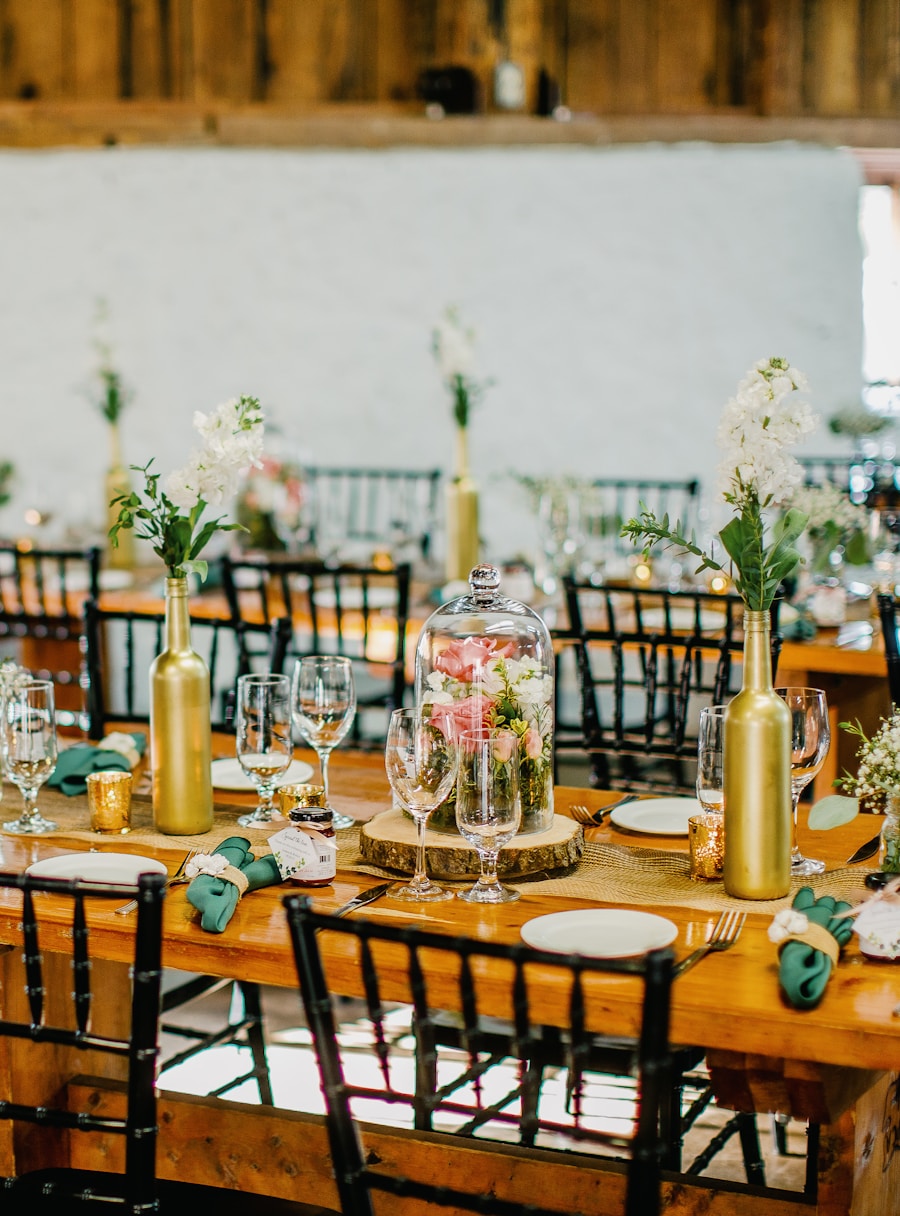The selection of table linens and centerpieces is a fundamental aspect of event design that can dramatically influence the overall aesthetic of a gathering. When choosing table linens, one must consider the fabric, color, and texture. For instance, a formal event may benefit from luxurious fabrics such as silk or satin, which exude elegance and sophistication.
Conversely, a casual gathering might call for more relaxed materials like cotton or linen, which can create a warm and inviting atmosphere. The color palette of the linens should harmonize with the event’s theme; for example, soft pastels can evoke a sense of springtime freshness, while deep jewel tones can add a touch of opulence. Centerpieces serve as focal points on each table and should complement the chosen linens while also reflecting the event’s theme.
A well-designed centerpiece can draw guests’ attention and spark conversation. For a wedding, floral arrangements in varying heights can create visual interest, while incorporating elements like candles or decorative stones can enhance the overall design. In contrast, a corporate event might benefit from sleek, modern centerpieces that incorporate elements like glass vases or geometric shapes.
The key is to strike a balance between creativity and functionality, ensuring that centerpieces do not obstruct guests’ views or impede conversation.
Key Takeaways
- Choose table linens and centerpieces that complement the overall theme and color scheme of the event
- Incorporate personalized details and favors to add a special touch for guests
- Select tableware and glassware that suits the formality and style of the event
- Create a cohesive theme and color scheme to tie the event together visually
- Utilize creative seating arrangements to encourage interaction and comfort for guests
- Enhance the ambiance with lighting and candles to create a warm and inviting atmosphere
- Incorporate greenery and floral arrangements to add natural beauty to the event space
- Ensure comfort and accessibility for guests by considering seating arrangements and venue layout
Incorporating Personalized Details and Favors
Personalization adds a unique touch to any event, making guests feel valued and appreciated. One effective way to incorporate personalized details is through custom place cards or seating assignments. These can be designed to reflect the theme of the event, whether it’s a wedding, birthday party, or corporate gathering.
For instance, a rustic-themed wedding might feature place cards made from wood slices with handwritten names, while a modern event could utilize sleek acrylic cards with elegant typography. This attention to detail not only enhances the aesthetic but also helps guests feel more connected to the occasion. Favors are another avenue for personalization that can leave a lasting impression on attendees.
Thoughtful favors that resonate with the theme of the event can serve as memorable keepsakes. For example, at a wedding, couples might choose to give guests small jars of honey or homemade jam, reflecting their love for local produce and artisanal craftsmanship. Alternatively, at a corporate event, branded items such as custom notebooks or pens can reinforce the company’s identity while providing practical use for attendees.
The key is to select favors that are meaningful and relevant to the occasion, ensuring they resonate with guests long after the event has concluded.
Selecting the Perfect Tableware and Glassware

The choice of tableware and glassware is crucial in setting the tone for an event. High-quality dinnerware can elevate the dining experience, making it feel more luxurious and special. When selecting plates, consider the style—whether it’s classic white porcelain for an elegant affair or colorful ceramic for a more casual gathering.
The shape of the plates can also play a role; round plates are traditional, while square or asymmetrical designs can add a contemporary flair. Additionally, incorporating unique serving dishes can enhance the presentation of food and create visual interest on the table. Glassware is equally important in complementing the tableware.
The type of glass used can vary depending on the beverages being served; for instance, crystal wine glasses can enhance the experience of fine wines, while mason jars might be more suitable for a rustic-themed event. It’s also essential to consider practicality; ensuring that glassware is easy to handle and not overly fragile will contribute to a more enjoyable dining experience for guests. Mixing different styles of glassware can also create an eclectic look that adds character to the table setting.
Creating a Cohesive Theme and Color Scheme
A cohesive theme and color scheme are vital components in creating an inviting atmosphere for any event. The theme serves as the backbone of the design, guiding decisions related to decor, table settings, and even attire. For instance, a vintage tea party theme might incorporate pastel colors, lace tablecloths, and mismatched china to evoke nostalgia and charm.
On the other hand, a modern minimalist theme could focus on monochromatic colors with clean lines and simple decor elements. The color scheme should be carefully curated to ensure harmony throughout the event space. Utilizing a color wheel can help in selecting complementary colors that work well together.
For example, pairing shades of blue with gold accents can create an elegant and sophisticated ambiance, while bright colors like coral and turquoise can infuse energy into a summer gathering. It’s also important to consider how colors will appear under different lighting conditions; what looks vibrant in daylight may appear muted in artificial light. By thoughtfully selecting a theme and color palette, hosts can create an immersive experience that resonates with guests.
Utilizing Creative Seating Arrangements
Seating arrangements play a significant role in shaping the dynamics of an event. A well-thought-out seating plan can encourage interaction among guests and foster a sense of community. Traditional round tables promote conversation but may limit interaction with those seated at opposite ends.
In contrast, long banquet tables can create a more communal atmosphere, allowing guests to engage with multiple people throughout the evening. Incorporating creative seating options can also enhance the overall experience. For example, lounge areas with comfortable seating arrangements can provide guests with a relaxed space to mingle away from formal dining tables.
Additionally, using varied seating styles—such as mixing chairs with benches or incorporating poufs—can add visual interest while accommodating different preferences for comfort. It’s essential to consider accessibility when planning seating arrangements; ensuring that pathways are clear and that all guests can easily navigate the space will contribute to an inclusive environment.
Enhancing the Ambiance with Lighting and Candles

Lighting is one of the most powerful tools in setting the mood for an event. The right lighting can transform an ordinary space into something magical and inviting. For formal events, soft ambient lighting can create an elegant atmosphere; this can be achieved through chandeliers or strategically placed uplights that wash walls in warm tones.
In contrast, for outdoor gatherings or casual events, string lights or lanterns can add a whimsical touch while providing functional illumination. Candles are another excellent way to enhance ambiance and create intimacy at an event. They come in various shapes and sizes—from tea lights nestled in glass holders to tall pillar candles arranged on centerpieces—allowing for versatility in design.
The flickering glow of candlelight not only adds warmth but also encourages relaxation among guests. When using candles, it’s important to consider safety; ensuring they are placed securely away from flammable materials and are monitored throughout the event will help prevent accidents.
Incorporating Greenery and Floral Arrangements
Greenery and floral arrangements are essential elements that bring life and vibrancy to any event setting. Fresh flowers can add color, texture, and fragrance, enhancing the overall sensory experience for guests. When selecting floral arrangements, consider seasonal blooms that align with the event’s theme; for example, peonies in spring or sunflowers in summer can evoke feelings associated with those seasons.
Incorporating greenery is equally important as it provides a lush backdrop that complements floral designs. Foliage such as ferns or eucalyptus can be used in centerpieces or as garlands along tables to create depth and dimension. Additionally, potted plants or herbs can serve as unique centerpieces that guests can take home as favors after the event.
The combination of flowers and greenery not only beautifies the space but also connects guests with nature, fostering a sense of tranquility.
Ensuring Comfort and Accessibility for Guests
Creating an enjoyable experience for guests goes beyond aesthetics; comfort and accessibility are paramount considerations when planning any event. Ensuring that seating is comfortable is essential; this includes providing adequate cushioning and space for movement around tables. Additionally, considering temperature control—whether through air conditioning or heating—can significantly impact guest comfort levels throughout the duration of an event.
Accessibility should also be prioritized to accommodate all guests, including those with mobility challenges. This includes ensuring pathways are wide enough for wheelchairs or walkers and that seating arrangements allow easy access without obstruction. Providing clear signage for restrooms and other facilities will help guide guests seamlessly throughout the venue.
By prioritizing comfort and accessibility, hosts demonstrate thoughtfulness towards their guests’ needs, creating an inclusive environment where everyone feels welcome and valued.
When designing reception tables, it is important to consider the overall ergonomic layout of the workspace. An article on creating ergonomic workstations (source) provides valuable insights on how to maximize comfort and productivity in an office setting. By incorporating ergonomic furniture and thoughtful interior design choices, such as those discussed in the article on interior design for offices (source), reception areas can be transformed into welcoming and efficient spaces for both employees and visitors. Additionally, the article on maximizing comfort with ergonomic furniture (source) offers practical tips for selecting the right furniture pieces to enhance the overall functionality and aesthetics of reception tables.
FAQs
What are reception tables?
Reception tables are tables used at events such as weddings, parties, and corporate functions to display items such as food, drinks, and decorations.
What are the different types of reception tables?
There are various types of reception tables, including round tables, rectangular tables, square tables, and high-top tables. Each type serves a different purpose and can be used for different events.
What are some common uses for reception tables?
Reception tables are commonly used to display food and drinks for guests to enjoy, as well as to showcase decorations and centerpieces. They can also be used for seating guests and as a focal point for the event’s design.
What materials are reception tables typically made of?
Reception tables are often made of wood, metal, or plastic. The choice of material depends on the style and theme of the event, as well as the durability and practicality needed for the specific use.
How can reception tables be decorated?
Reception tables can be decorated with tablecloths, runners, centerpieces, and other decorative elements to enhance the overall look and feel of the event. The choice of decorations will depend on the theme and style of the event.


